Comments (9)
Add Comment
-
 Views: 177
Views: 177
From the 1960's -
 Views: 206
Views: 206
Prather Product Land Sailer that donated a frame for my Parasail. -
 Views: 206
Views: 206
Even the over-size metal-arms on the servos was stuff on hand. -
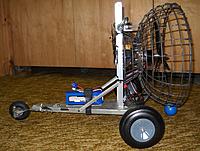 Views: 223
Views: 223
Wire fruit basket shroud around prop! -
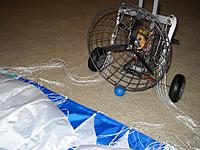 Views: 222
Views: 222
-
 Views: 196
Views: 196
Before final assembly weight was a good 1651 grams. Which was too light!
-
 Views: 216
Views: 216
After the plastic battery tray was glued to the top of the keel, I cut a large hole underneath it for the two servos. The plywood is used as a guide for arm fore/aft placement. -
 Views: 202
Views: 202
The two rotary servos stack one above the other, and have their control arms aligned vertically over the stock locations for the arms. -
 Views: 201
Views: 201
Servos are carefully positioned so that the top of their cases are in line with the sides of the fuselage and also perpendicular to the sides. So that only the output spline of the servo will show through the fuselage once wrapped in foam. -
 Views: 202
Views: 202
Servos casing were wrapped in clear tape, to seal them and add a bit of strength, then glued to the keel using UHU Por glue. -
 Views: 213
Views: 213
With the fuselage now wrapped in foam, one can see how the servos are in-line with this wrapping such that only the splined servo shaft protrudes. -
 Views: 203
Views: 203
Fun with creative clamping! Here securing the foam bottom cover to the fuselage with Super Phatic glue. -
 Views: 212
Views: 212
The finished assembly with servo arm in position. The scale control arm in the kit can be added onto the servo arm for higher fidelity. The white foam bit underneath the arm is where the arm would have been if built stock. This will be painted.
-
 Views: 237
Views: 237
I started with this Electric Flight Bird. Shipped well protected and arrived in good shape. Simple 1-channel ON/OFF control. -
 Views: 249
Views: 249
My Altaira Bird version # five next to box for size comparison. Wingspan is about 11 inches. -
 Views: 248
Views: 248
Altaira Bird version # five. Requires about 2 degrees of right rudder to counter drag from drooping left side wing. -
 Views: 269
Views: 269
Altaira Bird # 5 showing Spektrum brick control. -
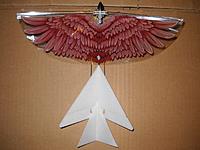 Views: 254
Views: 254
Altaira Bird version # five V-tail underneath smaller version 4 V-tail (minus control surfaces). #5 is 50% wider and offers stronger control response. -
 Views: 256
Views: 256
Weight of all stock parts is 15 grams. -
 Views: 245
Views: 245
Weight of Altaira bird version # four is 17 grams with 130mah flight battery. -
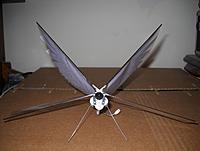 Views: 276
Views: 276
The two wing crank arms were replaced with black carbon fiber. Now with holes spaced closer together the wings still open enough.
-
 Views: 252
Views: 252
-
 Views: 266
Views: 266
AD/HD wing gluing to fuselage. Full size plan cut into templates for parts. All 3 of them! -
 Views: 247
Views: 247
Motor mount is a metal tube glued to rear of fuselage. A temporary motor is aligned for zero side thrust. -
 Views: 237
Views: 237
To balance at the recommended CG, two metal nuts are glued to the nose. After test gliding this AD/HD they were removed. -
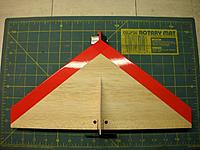 Views: 259
Views: 259
Finished airplane ready for maiden flight. -
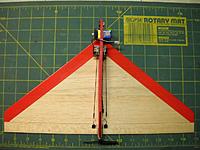 Views: 243
Views: 243
Bottom view showing component placement. -
 Views: 235
Views: 235
Foam fin is fixed and simply taped in place for easy repairs. -
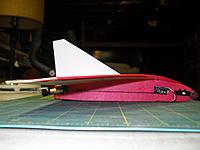 Views: 270
Views: 270
Close up of the airfoil. The motor thrust angle is overly steep and was reduced about half prior to maiden flight.
-
 Views: 233
Views: 233
C-17 packaged well and arrived without damage. -
 Views: 255
Views: 255
RTF apparently means something different to this manufacture. Notice picture on side of box of parts needing assembly before flying can be done. -
 Views: 223
Views: 223
Fuselage before cutting lengthwise. -
 Views: 228
Views: 228
Fuselage cut easily enough with a sharp knife. -
 Views: 216
Views: 216
Fuselage hollowed out to reduce weight.
-
 Views: 312
Views: 312
DW Rainbow 800 flying wing kit fully assembled. -
 Views: 305
Views: 305
Servos moved outward and forward, longer and taller fuselage center section fabricated, foam removed for propeller placement toward nose. -
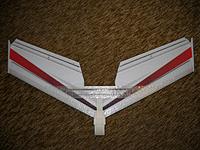 Views: 319
Views: 319
Carbon fiber rods added to central wing and control surfaces, reinforced tape added across central rods and leading edge of wing. -
 Views: 294
Views: 294
A small twist causing right roll from joining the left and right halves of the wing a bit crooked. -
 Views: 300
Views: 300
Foam nose cone added to protect longer fuselage. Reinforced tape allows for easy removal, repair, and redesign of nose. -
 Views: 306
Views: 306
Weight RTF with 1050mah 3-cell is 295 grams. Recommended flying weight is 165 grams. -
 Views: 308
Views: 308
Weight RTF is 10 - 3/8 ounces with 1050mah 3-cell lipo. -
 Views: 312
Views: 312
Size comparison of Rainbow 800mm wing to larger Zagi 400X 48 inch wing. Both are 3-cell power with Graupner 12 or 13 cm propellers. Zagi OEM motor is 3100KV and Rainbow motor installed is 2300KV.
-
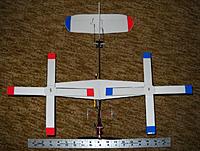 Views: 247
Views: 247
-
 Views: 253
Views: 253
-
 Views: 254
Views: 254
Not everyone appreciated my triangular fuselage shape, so succumbing to peer pressure I will redesign this in April 2018. -
 Views: 248
Views: 248
Landing gear is not all enough to rise off of the ground. -
 Views: 241
Views: 241
Most electronics on this side. -
 Views: 238
Views: 238
64 grams without 2-cell lipo battery. Otherwise ready to fly. -
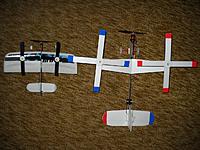 Views: 240
Views: 240
Comparison of my Twirl Tiny (1-cell on left) and Twirl Tween (2-cell on right). Note overly large wing added to Tiny to unload the motor in flight. Cheating, I know. -
 Views: 244
Views: 244
-
 Views: 242
Views: 242
Working from scaled down plans for the Twirl I adapted a framework out of carbon fiber rod, music wire, wood, and heat shrink tubing. -
 Views: 228
Views: 228
Foam from small food trays used for profile fuselage and stabilizer. -
 Views: 228
Views: 228
Test fit of foam, balsa, and CF rotors. -
 Views: 216
Views: 216
Spektrum circuit board installed and landing gear added. -
 Views: 255
Views: 255
Looking very much the Twirl design now with modest wing and all pieces of fuselage. -
 Views: 253
Views: 253
-
 Views: 226
Views: 226
23 grams total weight with a 7mm motor and a single 130-140mah lipo. -
 Views: 238
Views: 238
-
 Views: 417
Views: 417
Indoor model flying group on January 30, 1982. Cheboygan Michigan. That's me on both knees at the bottom right of the photo holding a scratchbuilt pusher canard. -
 Views: 370
Views: 370
Balsa Saucer as built and flown by Dad. -
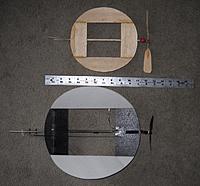 Views: 393
Views: 393
Dad's original 8 inch balsa freeflight Saucer and my foam 11 inch RC version. -
 Views: 397
Views: 397
Splash of orange on the fin and rudder is overspray from a Dynex 2.4 micro airplane kit. A scrap piece of foam from that kit is reused here. -
 Views: 383
Views: 383
Saucer 1982 ready for maiden flight on January 30, 2016 -
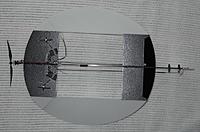 Views: 380
Views: 380
Bottom view showing simple wire landing gear and tidy motor wire routing. -
 Views: 378
Views: 378
Travel box cut from cardboard and styrofoam.
-
 Views: 344
Views: 344
Fuselage, fin, and rudder have holes added for weight savings. -
 Views: 340
Views: 340
Stabilizer, elevator, and wheel skirts also received holes. -
 Views: 362
Views: 362
Wing span increased by 25% with addition of one rib per half. Notice splices in balsa sheeting and length of leading edge stick. -
 Views: 344
Views: 344
Coloring of landing gear plywood with a Sharpie prior to assembly. Two coats minimum. -
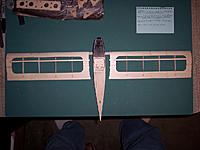 Views: 353
Views: 353
Splash of black added to battery cavity. -
 Views: 342
Views: 342
Combination of Aerolite covering and Sharpies used for basic detailing. -
 Views: 323
Views: 323
Headrest for pilot routed out to reduce weight. -
 Views: 376
Views: 376
Partially covered and testing of wing fit on January 12, 2015.
-
 Views: 367
Views: 367
It's Ironman! Hard to miss this box on the shelf! The missing box corners make opening it a PITA. -
 Views: 359
Views: 359
-
 Views: 344
Views: 344
He still fits in the box after my changes to the motors, TX, and landing gear. -
 Views: 356
Views: 356
Added are gearboxes and GWS4530 prop to the OEM motors. More than doubled the thrust. Still counter rotating. -
 Views: 353
Views: 353
Showing lines of the design. Quite a bit of reflex between the knees and toes. I haven't changed this, yet. -
 Views: 375
Views: 375
Landing gear sprung from swiveling motor bar. Motor bar also supporting the RX and plastic head. -
 Views: 343
Views: 343
Propeller thrust angles are original and rather pronounced! Black patch on chest over white circle is Velcro for the battery. -
 Views: 352
Views: 352
Showing three levels to fuselage.
-
 Views: 391
Views: 391
Micro S-Pou! after a January 2016 refreshing of a 2010 build. The much taller and bit longer fin and rudder design resulted from much trial and error. Turns are now smooth and predictable. -
 Views: 377
Views: 377
Back in 2012 the lifting stabilizer was replaced with this flat foam shaped a bit like the original fin. Covering the wing bottom changed it from under chambered to flat bottom with no flight degradation. -
 Views: 408
Views: 408
-
 Views: 392
Views: 392
A few stickers added to the sides for the heck of it! -
 Views: 382
Views: 382
Part of the refresh was a new storage box that has room for the unused stabilizer, fin, and rudder of the original design that I built.
-
 Views: 382
Views: 382
Fuselage rework showing the change to the landing gear holder with new square shape on the right for a friction fit with the music wire. -
 Views: 367
Views: 367
Dry-fitted prior to sanding. -
 Views: 362
Views: 362
Looks good from any angle! -
 Views: 343
Views: 343
Not a small micro airplane, and a bargain for the price of the kit. -
 Views: 378
Views: 378
Fuselage stained with Danish Oil and the wing painted with Torch Red automotive paint that matches my Corvette! -
 Views: 360
Views: 360
Aerolite covering partially applied, prior to assembly. -
 Views: 358
Views: 358
Observe new shape of the landing gear wire. Specifically the center bends where it slides into fuselage holder. -
 Views: 379
Views: 379
Assembled and awaiting finishing touches and the electronics.
-
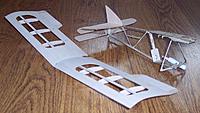 Views: 482
Views: 482
Majority of Sweet Dream ultralight kit is assembled and sanded. -
 Views: 467
Views: 467
Dry fitting of pieces to admire the proportions. -
 Views: 521
Views: 521
The open fuselage is what drew me to buy this model. -
 Views: 458
Views: 458
Yes, looks good enough to finish. -
 Views: 486
Views: 486
The British finishing kit is being installed. Stain is a medium-walnut Danish Oil. -
 Views: 508
Views: 508
Underside of wing is spray painted with Valspar radiance blend. The undersized GWS wheels will be replaced with larger ones before they are finished too. -
 Views: 507
Views: 507
Looks a little bare without the thread rigging and carbon fiber bracing! -
 Views: 486
Views: 486
-
 Views: 382
Views: 382
Sandy-Witch and Son-Of-A-Witch (without rider). -
 Views: 394
Views: 394
18 Inch span for Sandy and 9 inch for Sonny -
 Views: 356
Views: 356
Grocery bag covering to be replaced with black ultra-light covering. -
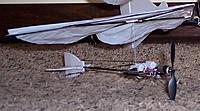 Views: 400
Views: 400
Son-Of-A-Witch without rider and prior to maiden flight. -
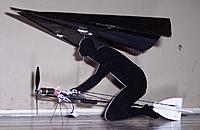 Views: 390
Views: 390
Sonny with new LiteSpan cape and foam pilot version 1. -
 Views: 354
Views: 354
March 12, 2014 the black cape was added. -
 Views: 364
Views: 364
Sonny lost weight! -
 Views: 343
Views: 343
Sonny is very thin :-)
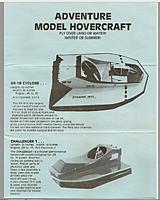
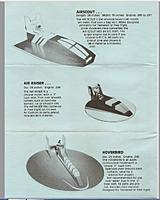

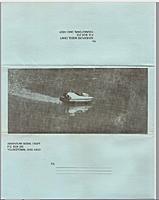

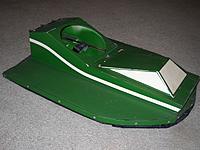
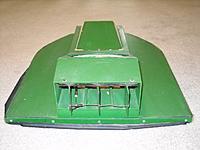




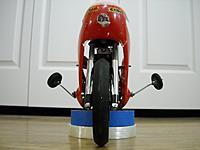







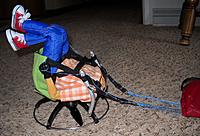

 Fortunately, my RC club's treasurer, Ned, has a family member who has flown the same paramotor for about 15 years. And I was treated to a flight of it at our club flying field in winds well above 10 mph. Glow engine powered, it flew very well never losing...
Fortunately, my RC club's treasurer, Ned, has a family member who has flown the same paramotor for about 15 years. And I was treated to a flight of it at our club flying field in winds well above 10 mph. Glow engine powered, it flew very well never losing...

 These nearly 20 year old wings endured my antics until summer of 2019, when the patriotic red-white-blue one crashed itself in a near vertical nose dive, after the ESC/BEC shut off during a high speed pass, through mature corn stalks onto the dry clay soil. The right half of the foam wing shattered under the tape finish, the center plastic battery holder fractured and hinged forward, and the twin fins sheared away.
These nearly 20 year old wings endured my antics until summer of 2019, when the patriotic red-white-blue one crashed itself in a near vertical nose dive, after the ESC/BEC shut off during a high speed pass, through mature corn stalks onto the dry clay soil. The right half of the foam wing shattered under the tape finish, the center plastic battery holder fractured and hinged forward, and the twin fins sheared away. 

 This is the vote thread from January 2017:
This is the vote thread from January 2017:
 They include:...
They include:... So I hand launched the first flight indoors during January 2018 with very encouraging results! Subsequent flights had me move the CG more-and-more toward the tail allowing for higher alpha and slower air speed. I also increased the right thrust of the motor another degree to compensate for the torque roll while in higher alpha flight. Thrust is not lacking from the GWS5030 propeller with easy vertical climbs and hovering. It is rather cool to see the rotor blades nearly stationary during a hover, only to accelerate again when moving forward.
So I hand launched the first flight indoors during January 2018 with very encouraging results! Subsequent flights had me move the CG more-and-more toward the tail allowing for higher alpha and slower air speed. I also increased the right thrust of the motor another degree to compensate for the torque roll while in higher alpha flight. Thrust is not lacking from the GWS5030 propeller with easy vertical climbs and hovering. It is rather cool to see the rotor blades nearly stationary during a hover, only to accelerate again when moving forward. Ironman just doesn't like to turn too tightly. That long and narrow body of his is acting like a rudder, of course, and when...
Ironman just doesn't like to turn too tightly. That long and narrow body of his is acting like a rudder, of course, and when...
